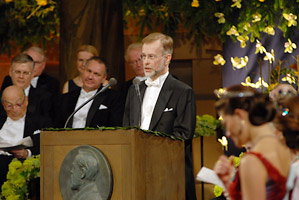Award ceremony speech
English
Presentation Speech by Professor Göran K. Hansson, Member of the Nobel Assembly at Karolinska Institutet, Chairman of the Nobel Committee for Physiology or Medicine, December 10, 2006.
 |
| Professor Göran K. Hansson delivering the Presentation Speech for the 2006 Nobel Prize in Physiology or Medicine at the Stockholm Concert Hall. Copyright © The Nobel Foundation 2006 Photo: Hans Mehlin |
Your Majesties, Your Royal Highnesses, Ladies and Gentlemen,
We live in an information society. A continuous flow of information reaches us through the news media and the internet. For modern man, the prioritisation and selection of information has become a necessary part of his survival strategy.
No information is more important to us than that which governs how we become humans. It instructs our stem cells to differentiate into nerve, blood and muscle cells, tells the organs how to develop and determines how we handle injuries and infections. That particular information is stored in our genome and it is used continuously in all our cells to make it possible for a nerve cell to function as a nerve cell and for a muscle cell to operate as a muscle cell.
It is remarkable that the entire instruction book on how to build a human being is present in each cell in our bodies. When reading that book, it is obviously of key importance that the muscle cell reads the muscle chapter only and does not end up as a frustrated nerve cell. Understanding how the genome is read has been a challenge for life science ever since Watson and Crick discovered, more than 50 years ago, that it is stored in the double helix of DNA.
It was soon established that genetic information is copied from DNA to a messenger RNA molecule, which in turn governs the production of proteins − the molecules that carry out the processes of life. And it was evident that if scientists could control the flow of information from DNA via RNA to protein, we would have marvellous tools at hand for use in medicine and biology.
Fifteen years ago, we thought we knew enough about the flow of genetic information to use it for practical purposes. But we did not achieve the expected results. Attempts to silence a gene in an experimental animal were sometimes fruitless, and attempts to use gene technology for improving the colours of flowers could even cause the plants to lose colour completely. These results perplexed the scientific community. Was there an unknown regulatory step on the way from DNA to protein?
This enigma was solved by the 2006 Nobel Laureates, Andrew Fire and Craig Mello. They suspected that RNA contained the solution to the problem and decided to test it in a simple model organism, the nematode worm Caenorhabditis elegans.
Fire and Mello injected different types of RNA into the worms – and usually nothing happened. But they also made the ingenious decision to mix two RNA molecules in a test tube before injection. One RNA molecule was an exact copy of a messenger RNA and the other a mirror image of the messenger. In the test tube, the two RNA molecules bound to each other and formed a double strand. Injection of that double-stranded RNA led to the silencing of the gene. Fire and Mello had discovered a new mechanism for controlling the flow of genetic information.
In their brilliant paper from 1998, Andrew Fire and Craig Mello demonstrated that double-stranded RNA activates an enzymatic mechanism that leads to gene silencing, with the genetic code in the RNA molecule determining which gene to silence. Today, we call this mechanism RNA interference.
Continued research has shown that our cells use RNA interference to regulate thousands of genes. Through RNA interference, the pattern of gene expression is fine-tuned in such a way that each cell uses precisely those genes that are needed for building its proteins. Today we also know that RNA interference helps to protect us against viruses and jumping genes. Finally, RNA interference can be used to control gene expression in the laboratory – and hopefully soon also in clinical medicine.
Professor Fire and Professor Mello,
Your discovery of RNA interference has unravelled a new principle for regulating the flow of genetic information. It has added a new dimension to our understanding of life and provided new tools for medicine. On behalf of the Nobel Assembly at Karolinska Institutet, I wish to convey to you our warmest congratulations and I ask you to step forward to receive the Nobel Prize from the hands of His Majesty the King.
Nobel Prizes and laureates
Six prizes were awarded for achievements that have conferred the greatest benefit to humankind. The 12 laureates' work and discoveries range from proteins' structures and machine learning to fighting for a world free of nuclear weapons.
See them all presented here.
